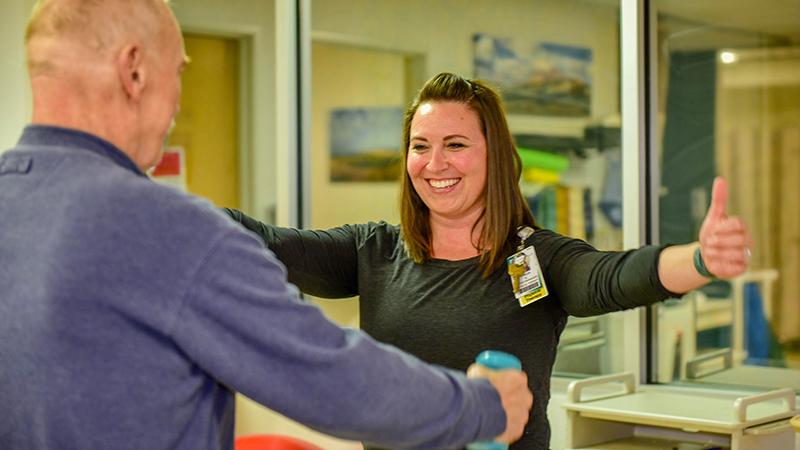
November 29, 2021
Co-authored by St. Peter’s Nurse Practitioner Andeelyn Wardell and St. Peter’s Wound Care Center Program Director Jane O’Driscoll, PT, WCC, CLT-LANA, CSWS
There are 34.2 million Americans who are diabetic and 64,000 of those are Montanans. We know that diabetes is associated with health issues such as neuropathy, causing sensation loss in hands and feet; and peripheral vascular disease, causing reduced blood flow in limbs resulting in damage to body tissues. Both of these conditions can contribute to wounds on the feet and legs. Other complications due to diabetes include cardiovascular disease, kidney damage, and damage to vision.
Diabetes and wound healing
Diabetes makes it very difficult for wounds to heal and diabetes-related wounds are the leading cause of limb loss in our country due to amputation. Amputations went up between 40-50% in our country over this past year due to pandemic-related access issues to wound care. Early prevention and education are key in preventing a wound before it happens. Early intervention is even more important in preventing infection and reducing healing time if a wound occurs. Amputation risk can be reduced by almost 50% when a multidisciplinary wound care team intervenes at the right time and provides care.
Risk factors for diabetic wounds
Diabetes risk factors include age, diet, activity levels, obesity, and heredity. Risk factors for a diabetic to develop a wound include neuropathy (loss of sensation), high blood sugar levels, poor circulation, and bony deformities in the foot, which is characteristic of diabetes. Approximately 25% of diabetic patients will develop a foot ulcer due to these risk factors. What’s more alarming is that approximately 40% of those with a healed diabetic wound will get another one within a year.
However, the three most significant risk factors are elevated blood sugar, high blood pressure, and high cholesterol. For each reduced percentage point in blood sugar level over time, there is reduction in risk for small blood vessel complications by 40%; a 10 point (mmHg) decrease in blood pressure can reduce that person’s risk for any diabetic complication by up to 12%; and control of serum lipids (cholesterol) can reduce that person’s risk for cardiovascular complications by 20% to 50%. The key to success is controlling blood sugars and preventing complications. Achieving glycemic control and seeking early treatment are imperative to wound healing. Having elevated blood sugar slows down wound healing.
Prevention tips
The American Diabetes Association recommends an annual diabetic foot exam by your provider to identify any changes or risks. It is important to monitor your feet regularly at home for any sores, cuts, or calluses. Those with diabetes are at higher risk for neuropathy in their feet. Neuropathy is the loss of feeling and can make one unaware of any blisters, sores, or injuries. It can then progress and lead to an ulcer and/or infection. Providers can then refer patients to podiatry or wound care. We strongly advocate for each of our diabetic patients to pay close attention to their feet at home in between visits. Elevated blood sugars can also damage blood vessels and this sometimes leads to heart attack or stroke. Kidney damage can be caused by high blood pressure and increased blood sugar making it difficult to clear extra fluid and waste from the body. Diabetes can also cause eye disease causing decreased vision and in extreme cases loss of vision.
Recommendations for prevention of a diabetic wound are:
- Don’t smoke.
- Get a foot exam from a qualified medial provider 4x per year – this can be your primary care provider or a podiatrist.
- Check your feet every day for nails that are too long or need attention, breaks in the skin, dry or red areas, or new areas of callouses or corns and if present have them addressed immediately by a qualified medical provider.
- Keep your feet clean and nails trimmed.
- Do not go barefoot and wear supportive footwear (including good socks, preferably with no seams).
- Eat a healthy diet and exercise. If you need help with these, ask your provider for referrals to a dietician and/or a physical therapist for guidance.
- Practice good blood sugar and blood pressure control, and weight management.
- If you are diabetic, make sure you are having regularly scheduled exams with your primary care provider and/or your endocrinologist.
Contributing Sources:
- Montana Department of Public Health and Human Resources, Montana Vital Statistics Analysis Unit, 2019
- Diabetic Wound Care | Foot Health | Patients | APMA
- Benefit of multidisciplinary wound care center on the volume and outcomes of a vascular surgery practice - Journal of Vascular Surgery (jvascsurg.org)
- An increased severity of peripheral arterial disease in the COVID-19 era (nih.gov)
- National Diabetes Statistics Report 2020: Estimates of diabetes and its burden in the United States. (cdc.gov)
- American Diabetes Association. Diabetes Care 2021 Jan; 44(Supplement 1): S151-S167. https://doi.org/10.2337/dc21-S011
- Epidemiology of Diabetes and Diabetes-Related Complications (nih.gov)


